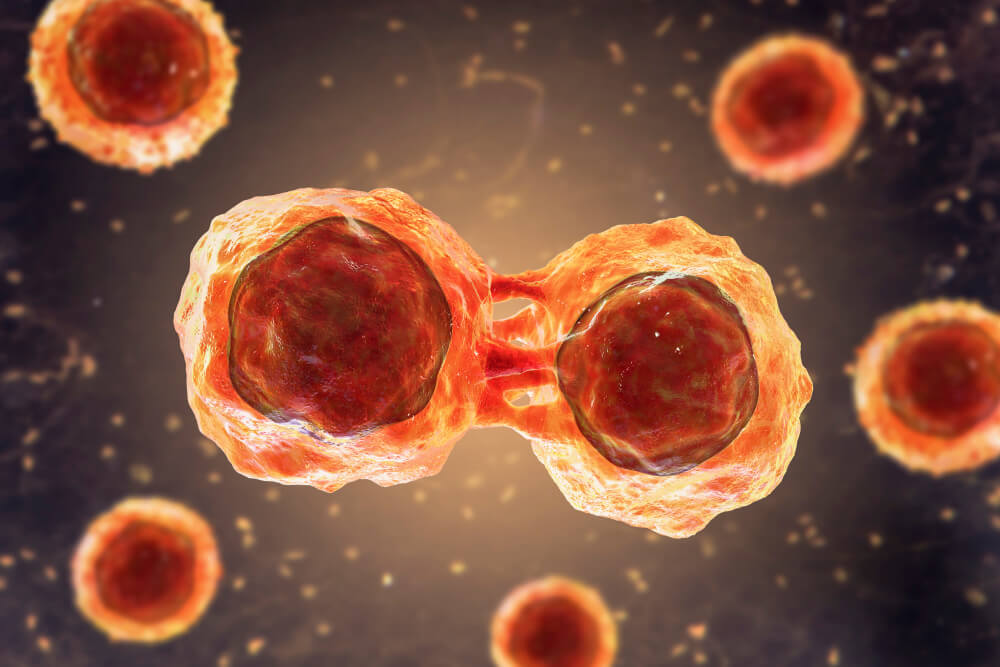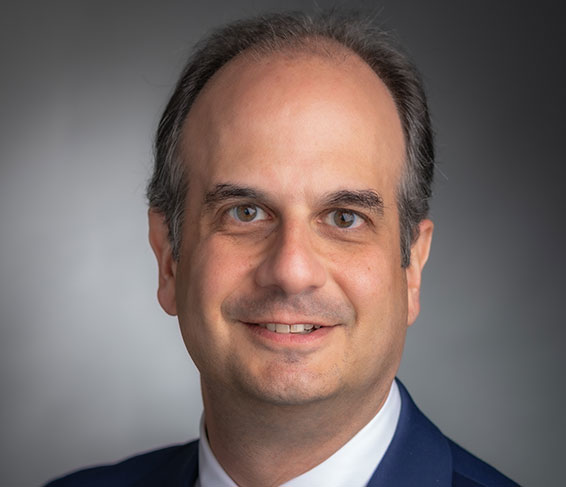Stem cell transplants are used to treat patients with a variety of blood-related cancers or non-cancerous blood conditions. They involve an infusion of healthy stem cells — either from the patient themself or a healthy donor — which regenerate all the blood cells needed by the body.
The Dana-Farber Brigham Cancer Center adult stem cell transplant program is one of the largest, most experienced such centers in the world, performing approximately 550 transplants each year and having performed more than 11,600 transplants in its history. With the Stem Cell Transplant Center at Dana-Farber/Boston Children’s Cancer and Blood Disorders Center, Dana-Farber is a national and world leader in stem cell transplantation. Patients at both centers benefit from transplant teams’ extensive experience in transplantation and in supporting and caring for patients during and after recovery.
What are stem cells?
Hematopoietic stem cells give rise to all the blood cells in the body — white blood cells, red blood cells, and platelets. The stem cells live in the bone marrow and their progeny — blood cells and platelets — move into the bloodstream. When a stem cell develops genetic mutations, it can pass these abnormalities on to its offspring, potentially leading to diseases such as leukemia, lymphoma, and multiple myeloma.

What diseases can be treated with stem cell transplants?
Cancers treated by transplant include:
- Acute lymphoblastic leukemia (ALL)
- Acute myeloid leukemia (AML)
- Chronic lymphocytic leukemia (CLL)
- Chronic myelogenous leukemia (CML)
- Hodgkin lymphoma
- Non-Hodgkin lymphoma
- Multiple myeloma
- Myelodysplastic syndromes
- Waldenström’s macroglobulinemia
- Some solid tumors, such as germ cell tumors and testicular cancer neuroblastoma in children
Non-cancerous blood disorders treated by transplant include:
- Aplastic anemia
- Sickle cell anemia
- Severe combined immunodeficiency syndrome
- Thalassemia
- Autoimmune diseases such as multiple sclerosis and scleroderma
- Inborn errors of metabolism, such as adrenoleukodystrophy
Who is eligible for a stem cell transplant?
Patients need to meet certain criteria involving their age, previous treatments, and overall health, as well as the type and stage of their cancer, the likelihood that it will respond to treatment, and, crucially, the availability of a suitable donor or ability to use the patient’s own stem cells.
How do stem cell transplants work?
The goal of a transplant is to replace diseased blood stem cells with healthy ones, generating healthy blood cells and a healthy immune system.
To accomplish that, patients are first treated with chemotherapy, sometimes in conjunction with radiation therapy, to wipe out or reduce the bone marrow. Radiation therapy works with chemotherapy to kill cancer cells in the bone marrow. In transplants involving stem cells from a donor, radiation therapy also suppresses the immune system, which helps prevent rejection of the donor cells.
After this initial therapy, patients receive an infusion of hematopoietic stem cells, which migrate to the bone marrow space and replenish the body’s supply of healthy blood cells. In patients with leukemia and other blood cancers, stem cells from a donor can also launch an immune attack on the cancer cells.
What is the goal of a stem cell transplant?
By replacing diseased blood cells with healthy ones, stem cell transplants can often cure or slow certain blood cancers or disorders that don’t respond, or have stopped responding, to other treatments.
What are the different types of stem cell transplants?
There are three main different types:
Autologous transplants, in which the transplanted cells come from the patient’s own body. The cells are removed from either the bone marrow or circulating blood and frozen while the patient receives high doses of chemotherapy and/or radiation therapy. The cells are then thawed and reinfused into the patient.
Autologous transplants are mainly used to treat leukemia, lymphoma, and multiple myeloma. Because the transplanted cells are the patient’s own, there’s no risk of rejection by the body or risk that the cells will launch an immune attack on healthy tissue. Sometimes, these cells are genetically modified before they are reinfused into the recipient. During this genetic modification (also known as gene therapy), abnormal genes causing a disease (such as sickle cell anemia or thalassemia) are corrected, leading to a cure of the genetic disease.
Allogeneic transplants, which use stem cells from a compatible donor, either a relative or non-relative. Like autologous transplants, allogeneic transplants are used to treat certain types of leukemia and lymphoma. The stem cells are collected from a donor, frozen, and then infused into the patient after chemotherapy and/or radiation therapy are complete. Sometimes, the cells are frozen, or “cryopreserved,” before they are infused if they will be needed at a later date.
Some allogeneic transplants involve stem cells from blood in a baby’s umbilical cord that have been frozen until needed. Such cells are less likely to be rejected by the body than cells from an adult donor. Transplants from cord blood may also take longer to begin producing new blood cells, potentially raising the risk of infection.
Syngeneic transplants, which use stem cells from a patient’s identical twin. Because the transplanted cells are genetically identical to the patient’s own, there is no risk of rejection or an immune attack on healthy tissue.
What are the basic steps of a stem cell transplant?
Autologous transplants
- Collecting stem cells: Patients receive medications to increase the number of stem cells in their blood and bone marrow. The cells are then collected through a process called apheresis in which blood is channeled through a machine that separates out the stem cells and returns the remainder to the body. The cells stored until needed. Time required: several days.
- Pre-transplant treatment: Patients receive high doses of chemotherapy to clear out or reduce the bone marrow, so the transplanted cells can take root there. Time required: five to ten days.
- Returning stem cells: Stem cells are reinfused into the patient. Time required: the procedure itself takes about an hour.
- Recovery: Patients are closely monitored to ensure stem cells take hold, or engraft, and successfully regenerate the body’s supply of blood cells. Antibiotics are given to prevent or reduce infection. Doctors also check for and treat side effects. As patients recover, the transplanted stem cells regenerate the blood supply, including the legions of white blood cells that that fight infection. Time required: 10-14 days, but full recovery of the immune system can take several months.
Allogeneic transplants
- Identifying a donor: A blood test is done to determine the patient’s HLA type, which refers to a specific set of proteins, called HLA antigens, on the body’s cells. HLA proteins are identification tags read by the immune system, which indicate whether a cell belongs in the body. Members of the patient’s care team then work to identify an individual whose HLA type matches the patient’s closely enough to be a stem cell donor. Often, the best match is a patient’s brother or sister, but unrelated individuals from the transplant registry and even parents and children can serve as donors.
- Collecting donor stem cells: The donor’s stem cells are collected and sent to the hospital where the transplant will be performed.
- Pre-transplant treatment: The patient is treated with chemotherapy, with our without radiation therapy, to prepare the body to receive the donor cells. Time required: five to seven days.
- Transplanting the cells: The donor stem cells are infused into the patient. Time required: the procedure itself takes about an hour.
- Recovery: Patients receive antibiotics to reduce their risk of infection. They also receive medications to prevent or manage graft-versus-host disease (GVHD), which occurs when donor stem cells attack the recipient’s tissues and organs. As patients recover, the transplanted stem cells regenerate the blood supply, including the legions of white blood cells that that fight infection Time required: 14-21 days, but full recovery of the immune system can up to a year or two.
Care teams at the Dana-Farber Brigham Cancer Center are highly trained and experienced in stem cell transplantation and provide supporting patients in all phases of the procedure and recovery.
Do transplants always require high doses of chemotherapy and/or radiation therapy?
Not always. A type of allogeneic transplant known as a reduced intensity transplant uses lower doses of chemotherapy to create space in the bone marrow for the new donor stem cells to grow. White blood cells made from the donor stem cells do most of the tumor cell killing. This type of allogeneic transplant can prevent rejection of the donor stem cells by suppressing the patient’s immune system.
What are the most common complications of a transplant?
One risk is that the transplanted cells aren’t effective against a patient’s illness. Another is a failure to engraft, in which the donor stem cells fail to take root in the patient’s bone marrow and generate new blood cells. GVHD is a risk in allogeneic transplants.
Patients may also be at high risk for infection while their blood cell counts recover. Antibiotics are helpful in these cases.
What are some of the side effects of transplant?
The high doses of chemotherapy and/or radiation therapy administered prior to a transplant can cause problems such as:
- bleeding
- increased risk of infection
- tiredness or exhaustion
Some of the short-term side effects of a transplant include:
- nausea
- fatigue
- loss of appetite
- mouth sores
- hair loss
- rashes
Long-term side effects may include:
- infertility
- cataracts
- liver, kidney, lung, or heart damage
- bone and muscle weakness
How long does it take to recover from a stem cell transplant?
It usually takes several months for patients to recover fully from an autologous transplant and one to two years from an allogeneic transplant.
What is new in stem cell transplantation?
At the Dana-Farber Brigham Cancer Center, many patients are eligible to receive a reduced-intensity allogeneic transplant or an autologous transplant on an outpatient basis. Instead of remaining in the hospital from the time of their initial chemotherapy treatment until discharge, they come to the clinic solely to receive treatment or follow-up care and tests. The rest of the time, they can stay in a nearby hotel or other residential accommodation.
New gene therapy has recently been approved to treat sickle cell anemia and thalassemia, two non-cancerous diseases of the blood. These are now available at Dana-Farber.
Newer methods of preventing and treating GVHD have improved outcomes after transplantation and made transplant available to those who might previously have not had a suitable donor.
About the Medical Reviewer

Dr. Cutler received his MD from McGill University, Montreal, Canada. He subsequently received his MPH from the Harvard school of Public Health. He completed postgraduate training in Internal Medicine at Royal Victoria Hospital, Montreal, followed by a fellowship in Hematology/Oncology at DFCI. In 2002, he joined DFCI, where he currently is a member of the Hematologic Malignancies staff.
